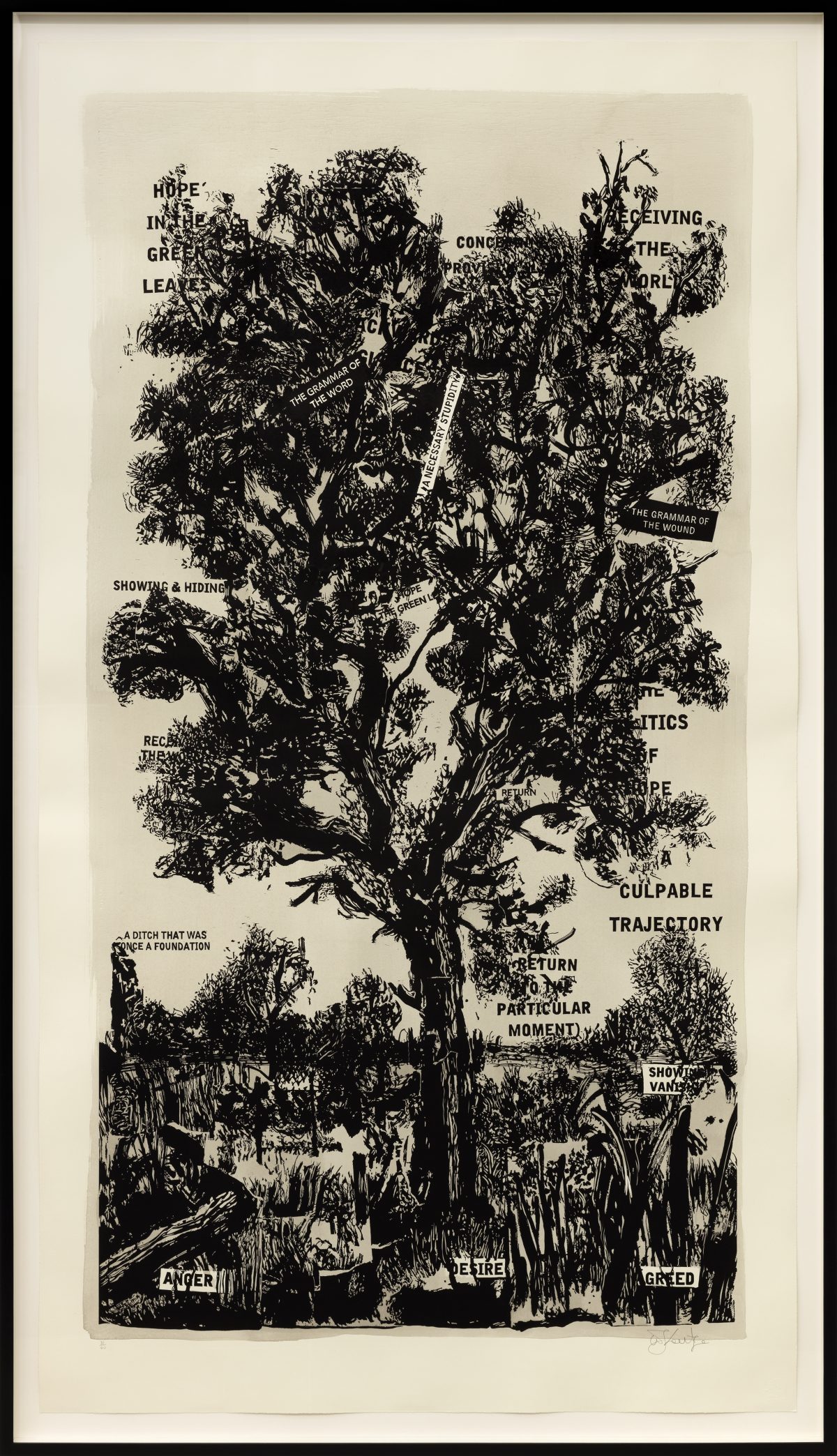
“Wait once again for better people” reads a leaflet under a bouquet in William Kentridge‘s “Hyacinths (Wait Once Again for Better People)” (2020). It sums up how many activists feel right now — frustrated with bad people clinging to their power. The work is one of many thought provoking prints on view right now at Marian Goodman gallery in William Kentridge: Making Prints: Selected Editions 1998-2021.
As a white South African man born in 1955, Kentridge has been grappling with apartheid and its aftermath for several decades. Now—amid shifts in national conversations about race — is a germane moment to revisit his prints from the past 23 years, many of which now shine in a different light. Making Prints offers a golden opportunity to revisit and rethink nuances that might have flown under the radar initially.

Kentridge has a long history of printing images over antiquarian books, including dictionary pages. “Universal Archives (Six Birds)” (2011), resonates with prophetic voices challenging what it means to “clamor,” “clarify,” “excel” or be part of “civilization.” In his bird linocuts, Kentridge probes how abstracted and rough the forms can get while still looking like a bird. The Universal Archive series grew out of Kentridge’s 2012 Norton Lectures at Harvard. There, he connected shadows in Plato’s Allegory of the Cave with misunderstandings of apartheid. Why was it so difficult to see the light and so easy to be fooled by the shadows? As symbols, these birds first and foremost represent those dark semblances that deceive.

In “Hope in the Green Leaves” (2013), Kentridge invites us into the complex resonances and dissonances of trees in his own story. As a boy in Johannesburg, he learned the word treason early on because his father worked as a lawyer defending anti-apartheid activists during the 1956 Treason Trial. He initially misheard it as his father venturing off to a place between “trees-and-tile,” phrases which sound alike in South African English. Several decades later, treason, justice, and trees remain interconnected for the artist. Speaking about his tendency to group words like those stashed in the branches, he once remarked that they can act as “riddles which are not solvable but hint towards a possible way of constructing.” Close looking uncovers phrases such as “the grammar of the wound,” “showing and hiding,” “necessary stupidity,” and “culpable trajectory” dangling from the branches. These words are hidden in the landscape, requiring some work to draw out and read. It’s a formal echo of the emotional process of digging in to face culpability, greed, desire, and anger.
Kentridge seldom works in color. His remarks in interviews chalk it up to personal distaste. But perhaps this preference for black and white also poses a challenge to the viewer, an urging to see issues of morality more starkly. Still, works of art don’t need to be comic books with explicit captions. The visual riddle has its own value. Trying to “figure it out” tells us more about our mental methods and particular relationships to the challenges these words evoke than anything else.
Elsewhere in Making Prints, Kentridge turns Opera upside down, confronting instead of validating white privilege with several prints from his 2006/2009 Nose series, which culminated in the Met Opera’s 2013 staging of Dmitri Shostakovich’s The Nose (1928). Kentridge directed and co-designed the production. The libretto starts with a bureaucrat awakening to find his nose missing, which he soon discovers has grown legs and gone rogue, walking about town. In the prints, this feral nose jumps onto various bodies. Figures appear receptive — their hands or bodies don’t engage with a struggle to get rid of it. This passivity towards the absurd purposely strikes a chord. As the artist once explained, “having been brought up in a society full of violence and absurdity I understood the Dadaists very well.” Foregrounding the absurd might seem like a dated homage. But the way these figures accept a gargantuan nose that warps and disfigures is hauntingly akin to the ways many accept the absurdity of racialized violence as normal.
William Kentridge: Making Prints: Selected Editions 1998-2021 is on view at Marian Goodman Gallery, New York (24 West 57th Street until April 17, 2021


0 Commentaires